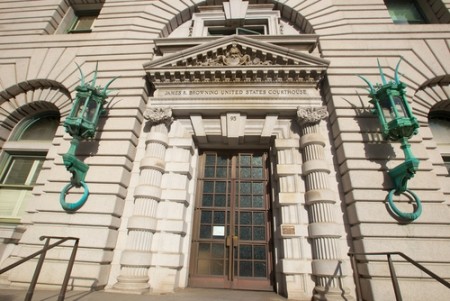Why might 9th Circuit judge have requested en banc rehearing vote on immigration order?

The 9th U.S. Circuit Court of Appeals in San Francisco.
White House policy adviser Stephen Miller is confident that President Donald Trump administration’s travel ban will be upheld, and it’s considering a variety of ways to achieve that.
Miller said on Fox News Sunday that the White House is considering a new executive order as well as requesting an emergency stay from the U.S. Supreme Court, an appeal of the 9th Circuit’s decision or more action at the Seattle district court, UPI reported.
Part of that decision may be taken from the White House, because the 9th Circuit on Friday called for a vote on en banc rehearing (PDF). An anonymous judge on the court requested the vote sua sponte, without a request from any of the parties. The parties—the federal government and the states of Washington and Minnesota—were asked to file briefs on the matter no later than 11 a.m. PT (2 p.m. ET) on Thursday, Feb. 16.
As the appeals court explains (PDF), a vote of the circuit’s judges will then be scheduled, and if a majority of active judges (29 on the 9th Circuit) agree, a panel of 11 judges will rehear the case.
The court notes that it gets 1,500 requests a year from parties for en banc rehearing, and 50 requests that come from a judge sua sponte. At his Immigration Courtside blog, retired immigration judge Paul Wickham Schmidt says there are three common reasons for a judge to call for an en banc vote. The judge may disagree with the decision and want a reversal; want the imprimatur of the full court on the ruling; or want a vehicle for judges who disagree with the ruling to express their displeasure. Schmidt believes the third option is most likely, but notes that we might never know, as the 9th Circuit has no obligation to explain denial of en banc rehearing.
The executive order, signed Jan. 27, cited national security as a reason for banning entry of all refugees to the country for 120 days and banning entry of nationals from Iran, Iraq, Libya, Somalia, Sudan, Syria and Yemen for 90 days. The order, which took effect immediately, caused widespread confusion at airports as travelers with valid visas—some with green cards—were detained, sent home or pressured to voluntarily relinquish their visas. It sparked worldwide protests and more than 40 court cases, including the case before the 9th Circuit.
A Seattle district court issued a broad temporary restraining order in response to the ban, which stopped enforcement. (Several prior orders were issued, but in some cases ignored.) The Trump administration asked the 9th Circuit for an emergency stay of that order, and the court heard oral arguments in the matter Feb. 7.
A ruling issued Feb. 9 declined to issue the stay, finding that the administration had not shown it was likely to succeed. The court was particularly sharp in rejecting the DOJ’s argument that executive orders on immigration are unreviewable in court, saying “There is no precedent to support this claimed unreviewability, which runs contrary to the fundamental structure of our constitutional democracy.”
On Friday, Trump told reporters that he would issue a new executive order, but advisers later said that was just one option under consideration. On Sunday, Miller told Fox News that legal action is still on the table, and that “the president’s powers here are beyond question.” The president himself has also expressed confidence that the ruling would be overturned—prior to the 9th Circuit’s ruling—and criticized the Seattle district judge who wrote it.
The ABA and some in the federal judiciary have raised concerns about judicial independence because of the president’s comments. Security has also been tightened for some judges involved in the case.



